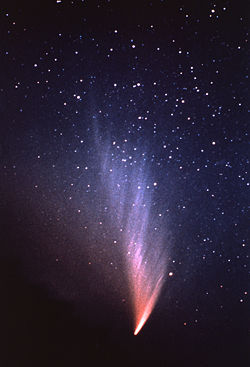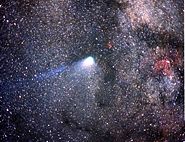Great Comet
2008/9 Schools Wikipedia Selection. Related subjects: Space (Astronomy)
A Great Comet is a comet which becomes particularly bright and is very spectacular to a casual observer on Earth. Great comets appear, on average, once every decade.
Predicting whether a comet will become a great comet is notoriously difficult, as many factors may cause a comet's brightness to depart drastically from predictions. Broadly speaking, if a comet has a large and active nucleus, will pass close to the Sun, and is not obscured by the Sun as seen from the Earth when at its brightest, it will have a chance of becoming a great comet.
While comets are officially named after their discoverers, some may come to be referred to as The Great Comet of... the year in which they were brightest.
Definition of a Great Comet
The definition of a great comet could obviously be quite subjective. However, any comet which becomes bright enough to be noticed by people who are not actively looking for it and becomes well known outside the astronomical community may come to be known as a great comet.
To most people, however, a great comet is simply a beautiful spectacle.
What makes a comet "great?"

The vast majority of comets are never bright enough to be seen by the naked eye. They generally pass through the inner solar system unseen by anyone except astronomers. However, occasionally, a comet may brighten to naked eye visibility, and even more rarely it may become as bright or brighter than the brightest stars. How bright a comet becomes depends on three main factors.
Size and activity of the nucleus
Cometary nuclei vary in size from a few hundreds of metres across or less to many kilometres across. When they approach the Sun, large amounts of gas and dust are ejected by cometary nuclei, due to solar heating. A crucial factor in how bright a comet becomes is how large and how active its nucleus is. After many returns to the inner solar system, cometary nuclei become depleted in volatile materials and thus are much less bright than comets which are making their first passage through the solar system.
Close perihelion approach
The brightness of a simple reflective body varies with the inverse square of its distance from the Sun. That is, if an object's distance from the Sun doubles, its brightness is quartered. However, comets behave differently due to their ejection of large amounts of volatile gas which then also reflect sunlight and may also fluoresce. Their brightness varies roughly as the inverse cube of their distance from the Sun, meaning that if a comet's distance from the Sun is halved, it will become eight times as bright.
This means that the peak brightness of a comet depends significantly on its distance from the Sun. For most comets, the perihelion of their orbit lies outside the Earth's orbit. Any comet approaching the Sun to within 0.5 AU or less may have a chance of becoming a Great Comet.
Close approach to the Earth
For a comet to become spectacular, it also needs to pass close to the Earth. Comet Halley, for example, is usually very bright when it passes through the inner solar system every seventy-six years, but during its 1986 apparition, its closest approach to Earth was almost the most distant possible. The comet became visible to the naked eye, but was definitely unspectacular.
A comet fulfilling all three of these criteria will certainly be spectacular. Sometimes, a comet failing on one criterion will still be extremely impressive. For example, Comet Hale-Bopp had an exceptionally large and active nucleus, but did not approach the Sun very closely at all. Despite this it still became an extremely famous and well observed comet. Equally, Comet Hyakutake was a rather small comet, but became bright because it passed extremely close to the Earth.
Previous Great Comets
Great Comets of the past two centuries have included the following:
- Great Comet of 1811
- Great Comet of 1843
- Donati's Comet - 1858
- Great Comet of 1861
- Great Comet of 1882
- Halley's Comet - 1910
- Great Daylight Comet of 1910
- Comet Skjellerup-Maristany - 1927
- Comet Arend-Roland - 1957
- Comet Seki-Lines - 1962
- Comet Ikeya-Seki - 1965
- Comet Bennett - 1970
- Comet West - 1976
- Comet Hyakutake - 1996
- Comet Hale-Bopp - 1997
- Comet McNaught - 2007
Great Comets of more than two centuries ago have included the following:
- Great Comet of 1106
- Great Comet of 1402
- Great Comet of 1577
- Great Comet of 1680
- Great Comet of 1729

